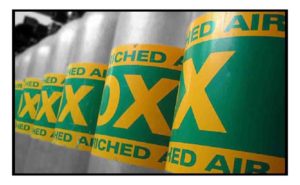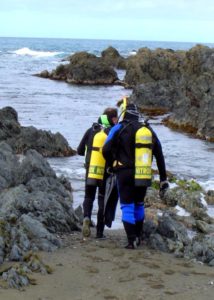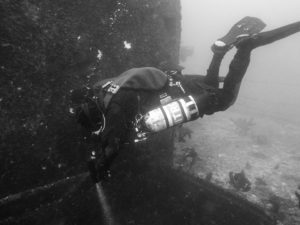 Although Nitrox has been used inrecreational diving for almost 25 years, it is still often misunderstood. As an instructor, I’ve found myself correcting countless students who are under the impression that Nitrox enables a person to dive deeper than normal air — this is just one of the common misconceptions about Nitrox diving. Although specific training is required before diving Nitrox for the first time, these basic facts will help to make more sense of what it is and what it can do for you.
Although Nitrox has been used inrecreational diving for almost 25 years, it is still often misunderstood. As an instructor, I’ve found myself correcting countless students who are under the impression that Nitrox enables a person to dive deeper than normal air — this is just one of the common misconceptions about Nitrox diving. Although specific training is required before diving Nitrox for the first time, these basic facts will help to make more sense of what it is and what it can do for you.
What Is It?
Nitrox refers to a mix of nitrogen and oxygen, regardless of the percentage of each in the mix. The Nitrox we use while diving is more properly called enriched-air Nitrox, and refers to any blend of nitrogen and oxygen in which the oxygen concentration is greater than that of normal air. This means an oxygen level of 22 percent or higher, although the most common enriched-air Nitrox blend is 32 percent. The recreational diving limit is 40 percent oxygen.
What Does It Do?
As every diver knows, increased pressure at depth causes the nitrogen in the air we breathe to be dissolved into the bloodstream. The time that we can spend underwater is limited by this nitrogen absorption — as we dive deeper and for longer, we absorb more nitrogen at a greater rate. Our no-decompression limit – maximum dive time relates to the amount of nitrogen our bodies can absorb before we must perform compulsory decompression stops or risk decompression sickness.
Enriched-air Nitrox reduces the rate at which nitrogen dissolves into our bloodstream, as there is less nitrogen available to be absorbed from the mix that we’re breathing. The higher the percentage of your enriched-air blend, the more nitrogen is replaced with extra oxygen.
Benefits
There are several reasons divers use enriched-air Nitrox. One of its biggest benefits is an increased no-decompression limit, which means longer bottom time. The lower percentage of nitrogen in the Nitrox you’re breathing means your bloodstream is also absorbing nitrogen more slowly. For example, on normal air a diver has a no-decompression limit of 50 minutes at 18m; using a 36 percent enriched-air mix at the same depth will extend this limit to 130 minutes. In terms of increasing bottom time, enriched air is most useful for depths between 18 and 30m; any shallower and no-decompression limits are already so long that divers usually have no need to extend them.
Surface intervals are usually shorter on Nitrox as well. Since there is less nitrogen to off-gas, a diver on enriched air will be able to re-enter the water sooner than a diver using normal air after completing the same profile. This also means that divers using enriched air typically have longer maximum bottom times on repetitive dives, and less off-gassing means that enriched air divers are often less tired at the end of the day than divers using normal air. Enriched air can be a valuable safety buffer for divers who choose to use it while following normal air limits. This creates a conservative margin that further reduces the risk of decompression sickness, and may be advisable for anyone who may be susceptible to it, such as those who are tired, overweight, and older have suffered decompression sickness before, or are diving with injuries.
Myths, Considerations and Dangers.
Although the benefits of diving with enriched air are significant, there are risks. One of the most common misconceptions about enriched air Nitrox is that users can dive deeper than with normal air; in fact the opposite is true. Under pressure, oxygen becomes toxic. The percentage of oxygen in normal air (21 percent) only becomes toxic at depths greater than the recreational limit, but the increased percentages of oxygen in enriched air mean that toxicity can become a problem at much shallower depths. Toxicity causes convulsions that put a diver at risk of losing his regulator and subsequently drowning. However, enriched-air courses teach divers how to work out their maximum operating depth using the percentage and partial pressure of the oxygen in their mix. As long as the maximum operating depth is adhered to, oxygen toxicity should not be a problem.
Oxygen also requires caution in the sense that it is an exceptionally flammable gas. Although standard scuba equipment is safe to use with air blends containing up to 40 percent oxygen, the process by which an enriched-air cylinder is filled may involve much higher concentrations. Partial-pressure blending exposes the cylinder to pure oxygen that is later diluted with normal air, and cylinders that are not treated for exposure to such high levels of oxygen can explode. Therefore, any part of the cylinder that comes in to contact with pure oxygen needs to be “oxygen clean,” and cylinders used for enriched air and normal air are not interchangeable. Enriched-air cylinders require decals or stickers to differentiate them from normal ones; they should be serviced annually.
There are a few other equipment considerations to bear in mind when considering enriched-air diving. Before each dive, you are personally responsible for checking the percentage of oxygen in your cylinder. If it is even slightly off, your maximum-operating depth calculations will be too. To check, you will need an analyzer, and although you can usually borrow one from your dive centre, it’s a good idea to have your own if you intend to dive Nitrox regularly. If you dive with a computer, you need to make sure that yours has enriched-air settings and correlates to the details of your mix before beginning each dive. Remember that using enriched air does not improve air consumption, and it will not prevent decompression sickness. Check your gauges, depth and time limits as often as you would when diving on normal air.
With these precautions and the necessary training, enriched-air diving is a fantastic way to get the most out of your diving experience. You’ll spend more time in the water, and less time waiting to get back in.
Simon – PADI Enriched Air Specialty Instructor


